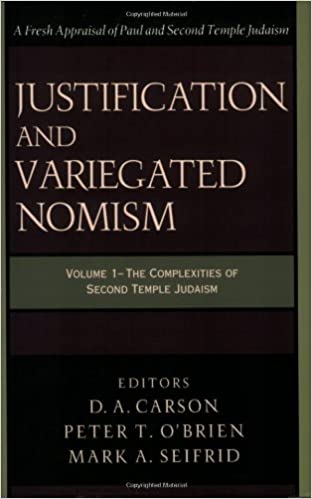A Brief Book Summary from Books At a Glance
by Nathan Sundt
Overview
The two volumes of Justification and Variegated Nomism engage with a broad array of issues that stretch from the texts of Second Temple Judaism to the nuances of Pauline interpretation, Reformation history, and Protestant theology. Many fine-grained discussions on theology, history, and New Testament exegesis are reserved for volume 2. Volume 1 focuses on what could be called the “academic bedrock” of the New Perspective on Paul, which has lent the view credence in academic Pauline studies, namely, the “covenantal nomism” model of Judaism that E. P. Sanders set forth in his book Paul and Palestinian Judaism. Therefore, volume 1 represents the necessary academic drudgery through nuanced discussions of obscure and underrepresented texts, exegesis of unpointed Aramaic and Pseudepigrapha, in order to interact with the central thesis that undergirds the New Perspective.
Table of Contents
- D. A. Carson, “Introduction”
- Daniel Falk, “Prayers and Psalms”
- Craig A. Evans, “Scripture-Based Stories in the Pseudepigrapha”
- Peter Enns, “Expansions of Scripture”
- Philip R. Davies, “Didactic Stories”
- Richard Bauckham, “Apocalypses”
- Robert A. Kugler, “Testaments”
- Donald E. Gowan, “Wisdom”
- Paul Spilsbury, “Josephus”
- Philip S. Alexander, “Torah and Salvation in Tannaitic Literature”
- Martin McNamara, “Some Targum Themes”
- David M. Hay, “Philo of Alexandria”
- Markus Bockmuehl, “1QS and Salvation at Qumran”
- Mark A. Seifrid, “Righteousness Language in the Hebrew Scriptures and Early Judaism”
- Roland Deines, “The Pharisees Between ‘Judaisms’ and ‘Common Judaism’”
- D. A. Carson, “Summaries and Conclusions”
Summary
Chapter 1: D. A. Carson, “Introduction”
D. A. Carson notes in his introductory chapter that Paul and Palestinian Judaism focused on the “literature of Second Temple Judaism, not on Paul. Almost 400 pages were devoted to the former, a mere ninety-two to the latter. That scarcely mattered for it was his treatment of Palestinian Judaism that proved broadly convincing to many” (2).
Sanders’s covenantal nomism included a “pattern of religion” that began with God’s election and gift of the law, divine acts that provided the means of atonement, and the establishment of the covenant relationship. Ultimately, the view argues, the near-universal pattern of religion in the Second Temple period considered election and salvation to be a matter of divine mercy, not moral human achievement. “To determine just how pervasive this pattern is, is one of the purposes of this volume” (3). Carson’s introductory chapter asserts that “‘covenantal nomism’ has become the shibboleth for understanding Second Temple Judaism, and the necessary background for understanding Paul” (4). In other words, covenantal nomism—or something very much like it—may operate in certain corners of Second Temple Judaism and in certain sectors of the literature.
Therefore, volume 1 needs only to establish that covenantal nomism is not, always and everywhere, characteristic of the whole of the literature and the complete historical account of the Second Temple Jewish community. If that thesis is established, a necessary corollary is that Paul does not need to be interpreted against a background of covenantal nomism with his Jewish interlocutors; a scholar could argue in a particular case for a background of covenantal nomism but, just as surely, could no longer assume covenantal nomism as the necessary backdrop. In this way, Carson admits that the results “are messy” but allow and prepare “for a more flexible approach to Paul” (5). Carson concludes with a metaphor, asserting that, if the volume meets its purpose, it will be like unbuckling a straightjacket on Second Temple studies in general and Pauline studies in particular. . . .
[To continue reading this summary, please see below....]The remainder of this article is premium content. Become a member to continue reading.
Already have an account? Sign In
Buy the books

JUSTIFICATION AND VARIEGATED NOMISM (VOLUME 1): THE COMPLEXITIES OF SECOND TEMPLE JUDAISM, edited by D. A. Carson, Peter T. O’Brien, and Mark A. Seifrid